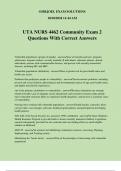Exam (elaborations)
UTA NURS 4462 Community Exam 2 Questions With Correct Answers
- Course
- Institution
©SIRJOEL EXAM SOLUTIONS 10/10/2024 11:44 AM UTA NURS 4462 Community Exam 2 Questions With Correct Answers Vulnerable populations (groups of people) - answerpoor or homeless persons, pregnant adolescents, migrant workers, severely mentally ill individuals, substance abusers, abused individual...
[Show more]



